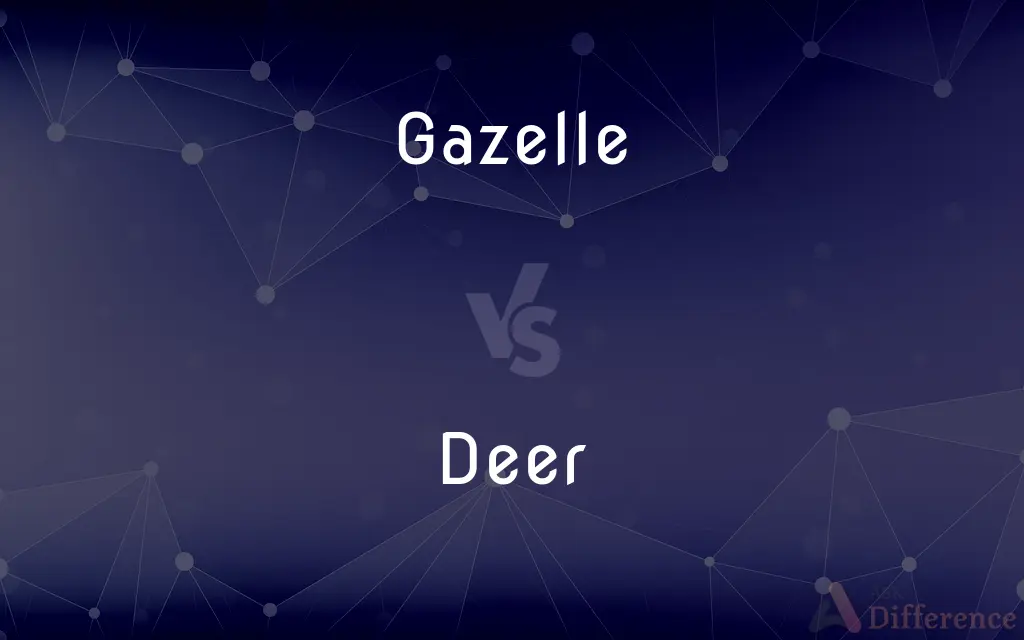Gazelle vs. Deer — What's the Difference?
By Maham Liaqat & Fiza Rafique — Updated on February 23, 2024
Gazelles are swift, slender antelopes known for their speed and grace in African and Asian habitats, while deer represent a broader family of hoofed mammals, widespread across various environments, distinguished by their antlers, primarily found in males.

Difference Between Gazelle and Deer
Table of Contents
ADVERTISEMENT
Key Differences
Gazelles and deer, both being hoofed mammals, belong to different families within the order Artiodactyla. Gazelles (family Bovidae) are adapted to arid environments such as savannas and deserts in Africa and Asia, showcasing remarkable speed and agility to evade predators. Their horns are typically ringed, curved, or straight, present in both genders, and they are known for their graceful movements and ability to leap and run swiftly.
Deer belong to the family Cervidae and are found in a variety of habitats, from tropical rainforests to arctic tundra. Deer species exhibit significant diversity in size and form, but most are characterized by the presence of antlers, which are usually found only in males (except in reindeer/caribou where both sexes have antlers). Antlers are shed and regrown annually, differentiating them from the permanent horns of gazelles.
The diets of both gazelles and deer are herbivorous, but their feeding habits may vary due to their differing habitats. Gazelles are primarily grazers, feeding on grasses and leaves, well-suited to the open plains. Deer, however, have more varied diets that can include grass, leaves, stems, and even bark, adapting to their diverse environments.
Gazelles are often found in herds, which can range from a few individuals to thousands in the case of the Serengeti's migration. Deer social structures vary widely among species; some form large herds, while others are more solitary or live in small family groups.
Conservation status also differs between gazelles and deer. Some gazelle species are endangered or critically endangered due to habitat loss, hunting, and predation. Deer populations also face threats, but their wider distribution and adaptability have allowed many species to maintain stable populations, with some even considered pests due to their impact on agriculture and forestry.
ADVERTISEMENT
Comparison Chart
Family
Bovidae
Cervidae
Habitat
Arid regions like savannas and deserts in Africa and Asia
Diverse, including forests, grasslands, and tundras worldwide
Horns/Antlers
Permanent horns in both male female, often ringed or curved
Antlers, mostly in males, shed and regrown annually
Diet
Primarily grasses and leaves, grazers
Varied, including grass, leaves, stems, and bark
Social Structure
Often found in herds
Varies widely, from solitary to large herds
Speed
Known for remarkable speed and agility
Varies by species, generally less focused on speed
Conservation
Some species endangered due to habitat loss and hunting
Wider distribution, some species considered pests
Compare with Definitions
Gazelle
They have permanent horns present in both males and females.
The horns of a Grant's gazelle are long and curved.
Deer
Social structures vary, with some deer living solitarily or in family groups.
Mule deer are often seen in small family groups.
Gazelle
Gazelles are primarily grazers, feeding on grasses.
Gazelles on the savanna feed on the abundant grasses available.
Deer
Most male deer grow and shed antlers annually.
Male elk, a type of deer, shed their large antlers each year.
Gazelle
Some species are at risk due to habitat loss and hunting.
The dama gazelle is critically endangered, with populations dwindling.
Deer
Deer populations are stable in many areas, with some considered overpopulated.
In some urban areas, deer populations have become a nuisance due to their abundance.
Gazelle
Gazelles are graceful antelopes known for their speed, found in Africa and Asia.
The Thomson's gazelle is renowned for its agility in evading predators.
Deer
Deer or true deer are hoofed ruminant mammals forming the family Cervidae. The two main groups of deer are the Cervinae, including the muntjac, the elk (wapiti), the red deer, the fallow deer, and the chital; and the Capreolinae, including the reindeer (caribou), the roe deer, the mule deer, and the moose.
Gazelle
Often found in large herds for protection against predators.
Gazelles gather in herds that can number in the hundreds during migrations.
Deer
Any of various hoofed ruminant mammals of the family Cervidae, characteristically having deciduous antlers borne chiefly by the males. The deer family includes the white-tailed deer, elk, moose, and caribou.
Gazelle
A gazelle is any of many antelope species in the genus Gazella. This article also deals with the seven species included in two further genera, Eudorcas and Nanger, which were formerly considered subgenera of Gazella.
Deer
A ruminant mammal with antlers and hooves of the family Cervidae, or one of several similar animals from related families of the order Artiodactyla.
Gazelle
A small, slender antelope that typically has curved horns and a fawn-coloured coat with white underparts, found in open country in Africa and Asia.
Deer
A ruminant of the genus Cervus, of many species, and of related genera of the family Cervidæ. The males, and in some species the females, have solid antlers, often much branched, which are shed annually. Their flesh, for which they are hunted, is called venison.
Gazelle
Any of various small, swift antelopes of the genus Gazella and related genera of Africa and Asia, characteristically having a slender neck and ringed horns.
Deer
Deer are a diverse family of mammals with species spread across various habitats.
The white tailed deer is common in North American forests.
Gazelle
An antelope of either of the genera Gazella (mostly native to Africa) or Procapra (native to Asia), capable of running at high speeds for long periods.
Deer
Deer diets can include grass, leaves, stems, and bark.
Deer in the forest often feed on underbrush and tree bark.
Gazelle
One of several small, swift, elegantly formed species of antelope, of the genus Gazella, esp. G. dorcas; - called also algazel, corinne, korin, and kevel. The gazelles are celebrated for the luster and soft expression of their eyes.
Gazelle
Small swift graceful antelope of Africa and Asia having lustrous eyes
Common Curiosities
Why do some deer species have antlers on both males and females?
In species like the reindeer/caribou, both genders have antlers, which are used for foraging through snow for food and as a defense mechanism.
Can deer and gazelles be found in the same habitat?
Deer and gazelles typically inhabit different regions and habitats, with gazelles found in Africa and Asia's arid landscapes and deer in a variety of habitats worldwide.
What distinguishes gazelle horns from deer antlers?
Gazelle horns are permanent and present in both gender, while deer antlers are mostly found in males and are shed and regrown annually.
Are gazelles faster than deer?
Gazelles are generally known for their exceptional speed and agility, which is a key survival trait in their open habitat, making them faster than most deer species.
What are the main conservation threats to gazelles?
Gazelles face threats from habitat loss, hunting, and competition with livestock, leading to declining populations in some species.
How do gazelles evade predators?
Gazelles use their speed and a high jump known as stotting or pronking to evade predators, making them difficult targets.
What role do gazelles play in their ecosystem?
Gazelles are important grazers, influencing vegetation patterns, and serve as prey for predators, contributing to the ecological balance.
Are all deer considered pests?
While not all deer are considered pests, in areas where their populations are high, they can damage crops and forests, leading to conflicts with humans.
How do deer adapt to different environments?
Deer have diverse diets and can live in a range of environments, from dense forests to open grasslands, showing remarkable adaptability.
What efforts are being made to conserve endangered gazelle species?
Conservation efforts include habitat protection, anti-poaching measures, and breeding programs to help restore endangered gazelle populations.
Share Your Discovery

Previous Comparison
Currently vs. Current
Next Comparison
Commemoration vs. AnniversaryAuthor Spotlight
Written by
Maham LiaqatCo-written by
Fiza RafiqueFiza Rafique is a skilled content writer at AskDifference.com, where she meticulously refines and enhances written pieces. Drawing from her vast editorial expertise, Fiza ensures clarity, accuracy, and precision in every article. Passionate about language, she continually seeks to elevate the quality of content for readers worldwide.














































